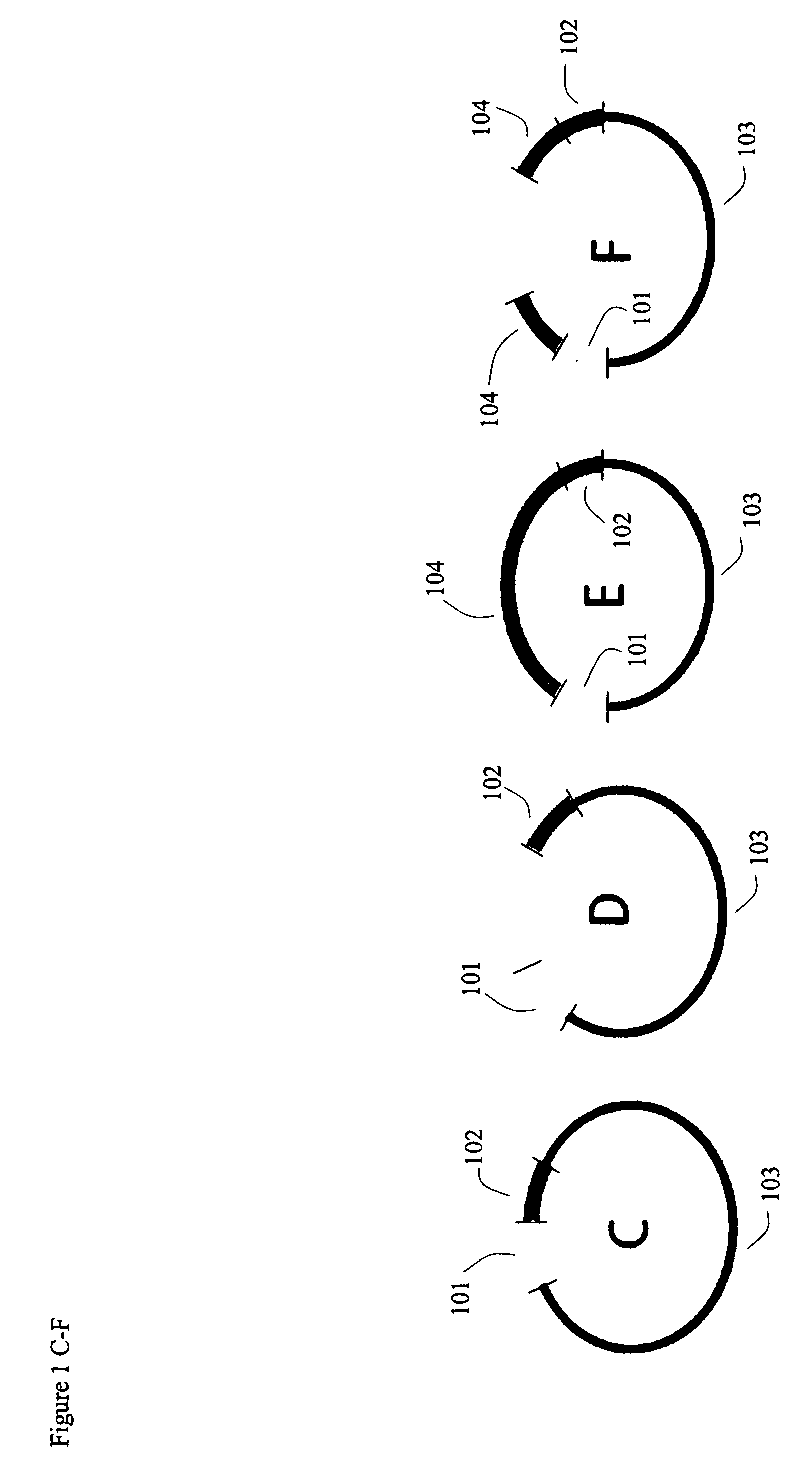Paired end sequencing
a technology of paired end and sequencing, which is applied in the field genomic sequencing, can solve the problems of time-consuming, difficult assembly, and large fragments of nucleic acid sequencing in the current sequencing apparatus, and achieves the effects of reducing the number of sequencing steps, and increasing the difficulty of assembly
- Summary
- Abstract
- Description
- Claims
- Application Information
AI Technical Summary
Benefits of technology
Problems solved by technology
Method used
Image
Examples
example 1
Oligonucleotide Design
[0253] Oligonucleotides used in the experiments are designed and synthesized as follows.
[0254] Capture element oligonucleotides, shown on the top part of FIG. 3A, are designed to include UA3 adaptors and keys. A NotI site is located between the adaptors. The complete construct (the capture element) may be created using nested oligos and PCR. The sequence of the final product is synthesized and cloned.
[0255] Type IIS capture fragment oligonucleotides, shown on the bottom part of FIG. 3A, are similar to the capture fragment described above except that sequences representing a type IIS restriction endonuclease site (e.g., MmeI) are included in the capture fragment after the key sequence. These type IIS restriction endonuclease cleavage sites permit the cleavage of any construct made with these capture elements to be cut with a type IIS restriction endonuclease. As known in the art, type IIS restriction endonucleases cleave DNA at various distances from the reco...
example 2
Protocol for the Hairpin Adaptor Paired End Sequencing
[0257]E. Coli K12 DNA (20 μg) in 100 μl was hydrosheared on speed 10 for 20 cycles using the standard HydroShear assembly (Genomic Solutions, Ann Arbor, Mich., USA). A methylation rection was performed on the sheared DNA by adding 50 μl of DNA (5 μg), 34.75 μl of H2O, 10 μl of methylase buffer, 0.25 μl of 32 mM SAM, and 5 μl of EcoRI methylase (40,000 units / ml, New England Biolabs (NEB), Ipswich, Mass., USA). The reactions were incubated for 30 minutes at 37° C. After the methylation reaction, the sheared, methylated DNA was purified using a Qiagen MinElute PCR Purification column, according to the manufacturer's instructions. The purified DNA was eluted from the column with 10 μl of EB buffer.
[0258] The sheared, methylated DNA was subjected to a polishing step to create sheared material having blunt ends. DNA at 10 μl was added to a reaction mixture containing 13 μl H2O, 5 μl of 10× polishing buffer, 5 μl of 1 mg / ml bovine ser...
example 3
Protocol for the Non Hairpin Adaptor Paired End Sequencing
[0266]E. Coli K12 DNA (5 μg) at 100 μl volume was hydrosheared on speed 11 for 20 cycles using a standard assembly (HydroShear, as above). The sheared DNA was purified on a Qiagen MinElute PCR Purification column according to the manufacturer's instructions and eluted with 23 μl of EB buffer. The purified sheared DNA was subjected to blunt-end polishing in a reaction mixture containing 23 μl of DNA, 5 μl of 10× polishing buffer, 5 μl of 1 mg / ml bovine serum albumin, 5 μl of 10 mM ATP, 3 μl of 10 mM dNTPs, 5 μl of 10 U / μl T4 polynucleotide kinase, and 5 μl of 3 U / μl T4 DNA polymerase. The reactions were incubated for 15 minutes at 12° C., after which the temperature was raised to 25° C. for another 15 minutes. The reactions were subsequently purified on a Qiagen MinElute PCR Purification column according to the manufacturer's instructions. Ligation of the non-hairpin adaptor was carried out using 2 μg of the sheared, purified...
PUM
| Property | Measurement | Unit |
|---|---|---|
| Digital information | aaaaa | aaaaa |
| Digital information | aaaaa | aaaaa |
| Digital information | aaaaa | aaaaa |
Abstract
Description
Claims
Application Information
 Login to View More
Login to View More - R&D
- Intellectual Property
- Life Sciences
- Materials
- Tech Scout
- Unparalleled Data Quality
- Higher Quality Content
- 60% Fewer Hallucinations
Browse by: Latest US Patents, China's latest patents, Technical Efficacy Thesaurus, Application Domain, Technology Topic, Popular Technical Reports.
© 2025 PatSnap. All rights reserved.Legal|Privacy policy|Modern Slavery Act Transparency Statement|Sitemap|About US| Contact US: help@patsnap.com



